Analysis of Interprofessional Practice and Patient Safety Report
VerifiedAdded on 2022/12/15
|11
|2804
|145
Report
AI Summary
This report delves into the critical aspects of interprofessional practice and patient safety within healthcare settings. It begins by defining interprofessional practice and emphasizing its role in enhancing patient experience, preventing medical errors, and improving service delivery. The report examines 'failure to rescue,' its causes, and the adverse events associated with it, such as lack of competence, incomplete documentation, and communication failures. It analyzes the consequences of failure to rescue on patients, their families, and the healthcare system, highlighting the negative impacts on patient health, family finances, and the reputation of healthcare providers. Furthermore, the report explores nursing strategies like careful patient monitoring and rapid response teams as effective interventions to mitigate failure to rescue and maintain patient safety, concluding with the importance of coordinated healthcare efforts for positive patient outcomes.
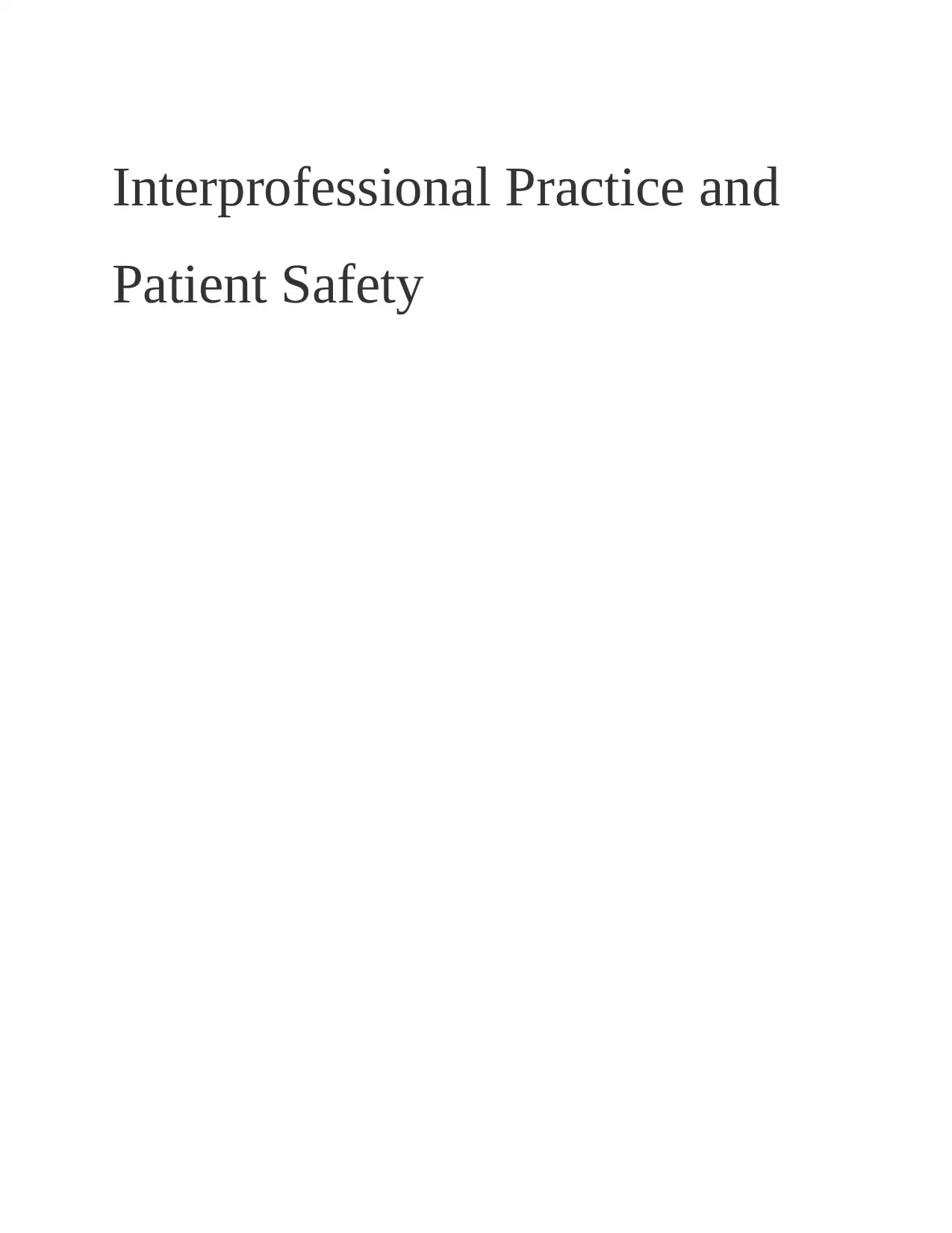
Interprofessional Practice and
Patient Safety
Patient Safety
Paraphrase This Document
Need a fresh take? Get an instant paraphrase of this document with our AI Paraphraser

Table of Contents
INTRODUCTION ..........................................................................................................................3
CONCLUSION..............................................................................................................................10
REFERENCES..............................................................................................................................11
INTRODUCTION ..........................................................................................................................3
CONCLUSION..............................................................................................................................10
REFERENCES..............................................................................................................................11
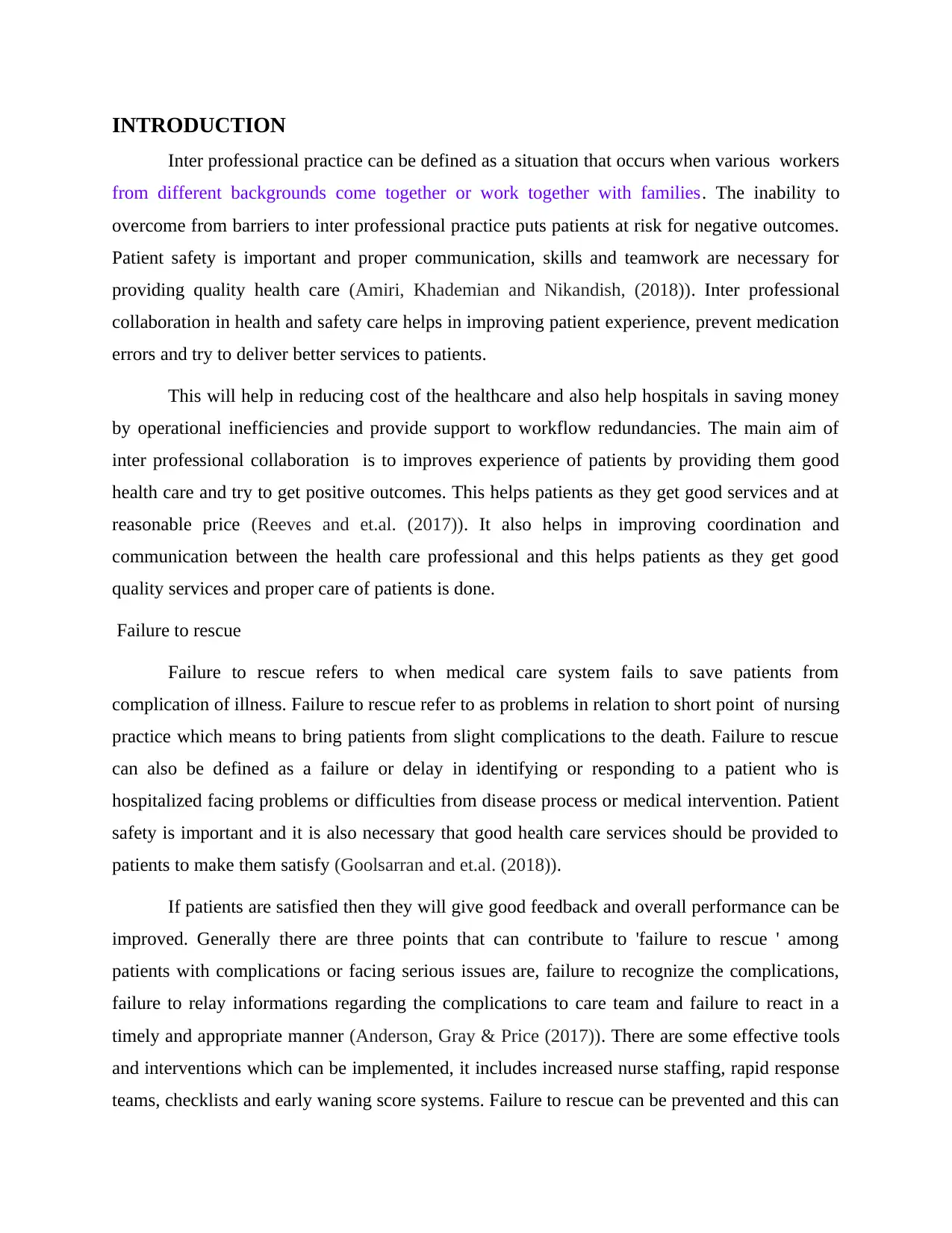
INTRODUCTION
Inter professional practice can be defined as a situation that occurs when various workers
from different backgrounds come together or work together with families. The inability to
overcome from barriers to inter professional practice puts patients at risk for negative outcomes.
Patient safety is important and proper communication, skills and teamwork are necessary for
providing quality health care (Amiri, Khademian and Nikandish, (2018)). Inter professional
collaboration in health and safety care helps in improving patient experience, prevent medication
errors and try to deliver better services to patients.
This will help in reducing cost of the healthcare and also help hospitals in saving money
by operational inefficiencies and provide support to workflow redundancies. The main aim of
inter professional collaboration is to improves experience of patients by providing them good
health care and try to get positive outcomes. This helps patients as they get good services and at
reasonable price (Reeves and et.al. (2017)). It also helps in improving coordination and
communication between the health care professional and this helps patients as they get good
quality services and proper care of patients is done.
Failure to rescue
Failure to rescue refers to when medical care system fails to save patients from
complication of illness. Failure to rescue refer to as problems in relation to short point of nursing
practice which means to bring patients from slight complications to the death. Failure to rescue
can also be defined as a failure or delay in identifying or responding to a patient who is
hospitalized facing problems or difficulties from disease process or medical intervention. Patient
safety is important and it is also necessary that good health care services should be provided to
patients to make them satisfy (Goolsarran and et.al. (2018)).
If patients are satisfied then they will give good feedback and overall performance can be
improved. Generally there are three points that can contribute to 'failure to rescue ' among
patients with complications or facing serious issues are, failure to recognize the complications,
failure to relay informations regarding the complications to care team and failure to react in a
timely and appropriate manner (Anderson, Gray & Price (2017)). There are some effective tools
and interventions which can be implemented, it includes increased nurse staffing, rapid response
teams, checklists and early waning score systems. Failure to rescue can be prevented and this can
Inter professional practice can be defined as a situation that occurs when various workers
from different backgrounds come together or work together with families. The inability to
overcome from barriers to inter professional practice puts patients at risk for negative outcomes.
Patient safety is important and proper communication, skills and teamwork are necessary for
providing quality health care (Amiri, Khademian and Nikandish, (2018)). Inter professional
collaboration in health and safety care helps in improving patient experience, prevent medication
errors and try to deliver better services to patients.
This will help in reducing cost of the healthcare and also help hospitals in saving money
by operational inefficiencies and provide support to workflow redundancies. The main aim of
inter professional collaboration is to improves experience of patients by providing them good
health care and try to get positive outcomes. This helps patients as they get good services and at
reasonable price (Reeves and et.al. (2017)). It also helps in improving coordination and
communication between the health care professional and this helps patients as they get good
quality services and proper care of patients is done.
Failure to rescue
Failure to rescue refers to when medical care system fails to save patients from
complication of illness. Failure to rescue refer to as problems in relation to short point of nursing
practice which means to bring patients from slight complications to the death. Failure to rescue
can also be defined as a failure or delay in identifying or responding to a patient who is
hospitalized facing problems or difficulties from disease process or medical intervention. Patient
safety is important and it is also necessary that good health care services should be provided to
patients to make them satisfy (Goolsarran and et.al. (2018)).
If patients are satisfied then they will give good feedback and overall performance can be
improved. Generally there are three points that can contribute to 'failure to rescue ' among
patients with complications or facing serious issues are, failure to recognize the complications,
failure to relay informations regarding the complications to care team and failure to react in a
timely and appropriate manner (Anderson, Gray & Price (2017)). There are some effective tools
and interventions which can be implemented, it includes increased nurse staffing, rapid response
teams, checklists and early waning score systems. Failure to rescue can be prevented and this can
⊘ This is a preview!⊘
Do you want full access?
Subscribe today to unlock all pages.

Trusted by 1+ million students worldwide
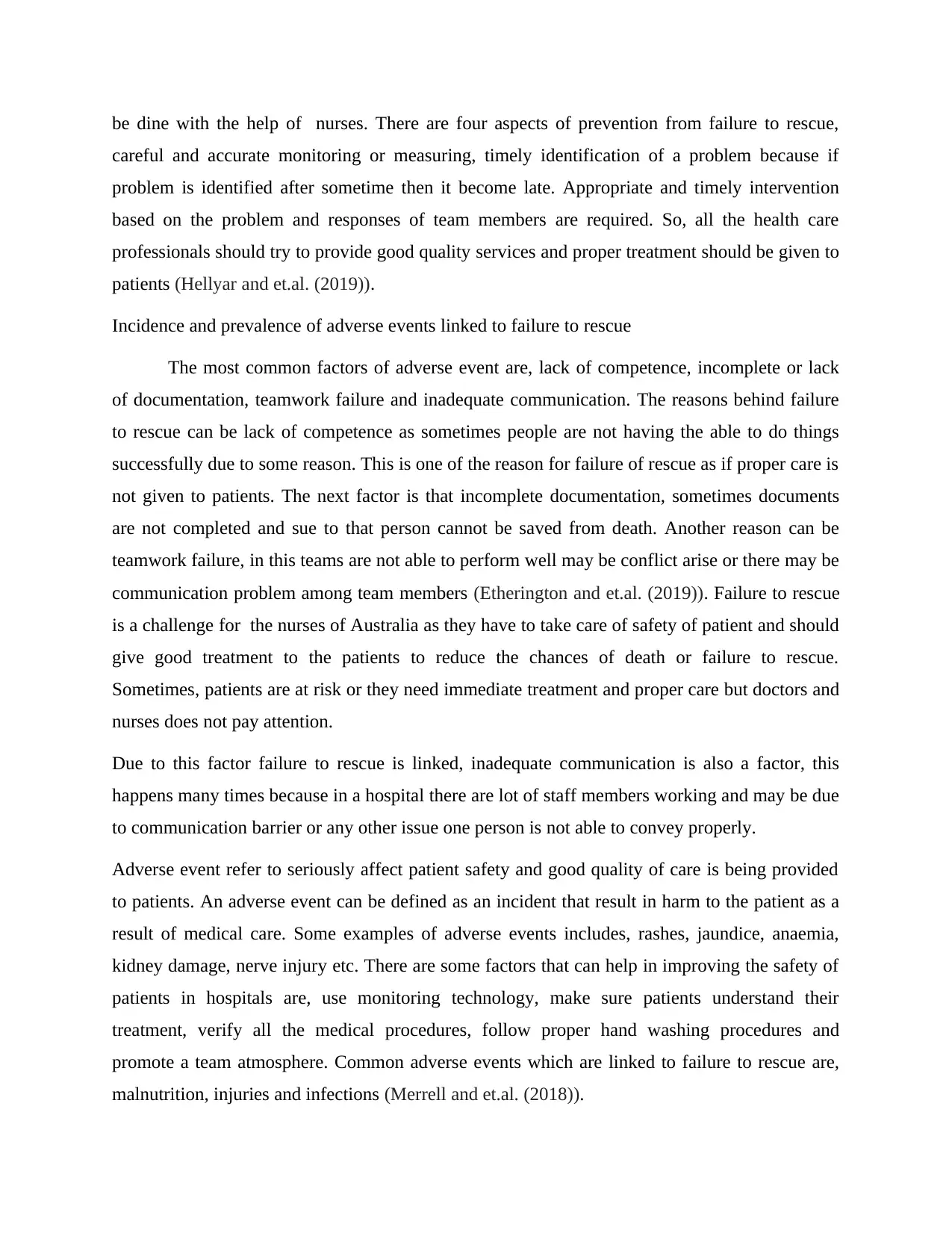
be dine with the help of nurses. There are four aspects of prevention from failure to rescue,
careful and accurate monitoring or measuring, timely identification of a problem because if
problem is identified after sometime then it become late. Appropriate and timely intervention
based on the problem and responses of team members are required. So, all the health care
professionals should try to provide good quality services and proper treatment should be given to
patients (Hellyar and et.al. (2019)).
Incidence and prevalence of adverse events linked to failure to rescue
The most common factors of adverse event are, lack of competence, incomplete or lack
of documentation, teamwork failure and inadequate communication. The reasons behind failure
to rescue can be lack of competence as sometimes people are not having the able to do things
successfully due to some reason. This is one of the reason for failure of rescue as if proper care is
not given to patients. The next factor is that incomplete documentation, sometimes documents
are not completed and sue to that person cannot be saved from death. Another reason can be
teamwork failure, in this teams are not able to perform well may be conflict arise or there may be
communication problem among team members (Etherington and et.al. (2019)). Failure to rescue
is a challenge for the nurses of Australia as they have to take care of safety of patient and should
give good treatment to the patients to reduce the chances of death or failure to rescue.
Sometimes, patients are at risk or they need immediate treatment and proper care but doctors and
nurses does not pay attention.
Due to this factor failure to rescue is linked, inadequate communication is also a factor, this
happens many times because in a hospital there are lot of staff members working and may be due
to communication barrier or any other issue one person is not able to convey properly.
Adverse event refer to seriously affect patient safety and good quality of care is being provided
to patients. An adverse event can be defined as an incident that result in harm to the patient as a
result of medical care. Some examples of adverse events includes, rashes, jaundice, anaemia,
kidney damage, nerve injury etc. There are some factors that can help in improving the safety of
patients in hospitals are, use monitoring technology, make sure patients understand their
treatment, verify all the medical procedures, follow proper hand washing procedures and
promote a team atmosphere. Common adverse events which are linked to failure to rescue are,
malnutrition, injuries and infections (Merrell and et.al. (2018)).
careful and accurate monitoring or measuring, timely identification of a problem because if
problem is identified after sometime then it become late. Appropriate and timely intervention
based on the problem and responses of team members are required. So, all the health care
professionals should try to provide good quality services and proper treatment should be given to
patients (Hellyar and et.al. (2019)).
Incidence and prevalence of adverse events linked to failure to rescue
The most common factors of adverse event are, lack of competence, incomplete or lack
of documentation, teamwork failure and inadequate communication. The reasons behind failure
to rescue can be lack of competence as sometimes people are not having the able to do things
successfully due to some reason. This is one of the reason for failure of rescue as if proper care is
not given to patients. The next factor is that incomplete documentation, sometimes documents
are not completed and sue to that person cannot be saved from death. Another reason can be
teamwork failure, in this teams are not able to perform well may be conflict arise or there may be
communication problem among team members (Etherington and et.al. (2019)). Failure to rescue
is a challenge for the nurses of Australia as they have to take care of safety of patient and should
give good treatment to the patients to reduce the chances of death or failure to rescue.
Sometimes, patients are at risk or they need immediate treatment and proper care but doctors and
nurses does not pay attention.
Due to this factor failure to rescue is linked, inadequate communication is also a factor, this
happens many times because in a hospital there are lot of staff members working and may be due
to communication barrier or any other issue one person is not able to convey properly.
Adverse event refer to seriously affect patient safety and good quality of care is being provided
to patients. An adverse event can be defined as an incident that result in harm to the patient as a
result of medical care. Some examples of adverse events includes, rashes, jaundice, anaemia,
kidney damage, nerve injury etc. There are some factors that can help in improving the safety of
patients in hospitals are, use monitoring technology, make sure patients understand their
treatment, verify all the medical procedures, follow proper hand washing procedures and
promote a team atmosphere. Common adverse events which are linked to failure to rescue are,
malnutrition, injuries and infections (Merrell and et.al. (2018)).
Paraphrase This Document
Need a fresh take? Get an instant paraphrase of this document with our AI Paraphraser
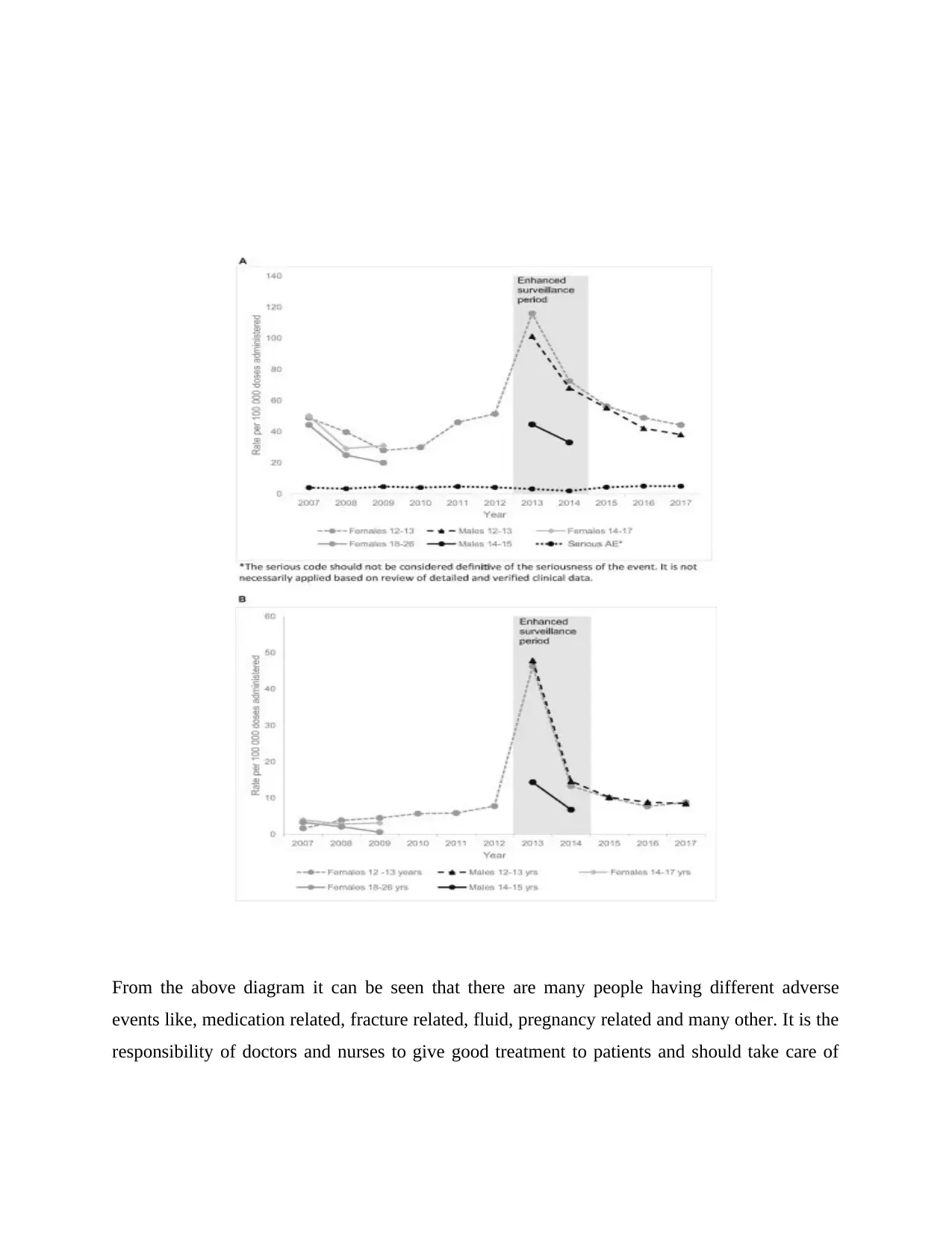
From the above diagram it can be seen that there are many people having different adverse
events like, medication related, fracture related, fluid, pregnancy related and many other. It is the
responsibility of doctors and nurses to give good treatment to patients and should take care of
events like, medication related, fracture related, fluid, pregnancy related and many other. It is the
responsibility of doctors and nurses to give good treatment to patients and should take care of
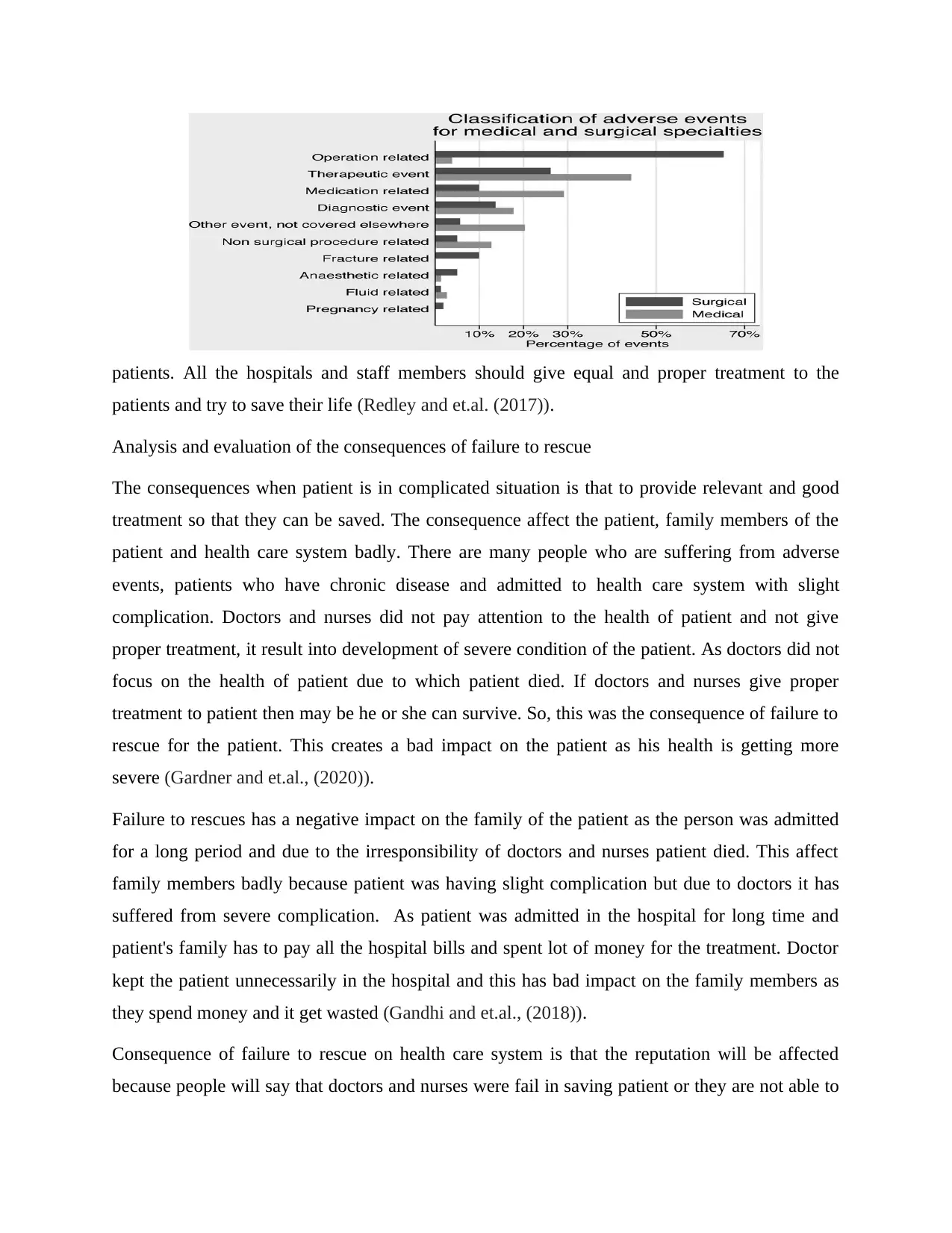
patients. All the hospitals and staff members should give equal and proper treatment to the
patients and try to save their life (Redley and et.al. (2017)).
Analysis and evaluation of the consequences of failure to rescue
The consequences when patient is in complicated situation is that to provide relevant and good
treatment so that they can be saved. The consequence affect the patient, family members of the
patient and health care system badly. There are many people who are suffering from adverse
events, patients who have chronic disease and admitted to health care system with slight
complication. Doctors and nurses did not pay attention to the health of patient and not give
proper treatment, it result into development of severe condition of the patient. As doctors did not
focus on the health of patient due to which patient died. If doctors and nurses give proper
treatment to patient then may be he or she can survive. So, this was the consequence of failure to
rescue for the patient. This creates a bad impact on the patient as his health is getting more
severe (Gardner and et.al., (2020)).
Failure to rescues has a negative impact on the family of the patient as the person was admitted
for a long period and due to the irresponsibility of doctors and nurses patient died. This affect
family members badly because patient was having slight complication but due to doctors it has
suffered from severe complication. As patient was admitted in the hospital for long time and
patient's family has to pay all the hospital bills and spent lot of money for the treatment. Doctor
kept the patient unnecessarily in the hospital and this has bad impact on the family members as
they spend money and it get wasted (Gandhi and et.al., (2018)).
Consequence of failure to rescue on health care system is that the reputation will be affected
because people will say that doctors and nurses were fail in saving patient or they are not able to
patients and try to save their life (Redley and et.al. (2017)).
Analysis and evaluation of the consequences of failure to rescue
The consequences when patient is in complicated situation is that to provide relevant and good
treatment so that they can be saved. The consequence affect the patient, family members of the
patient and health care system badly. There are many people who are suffering from adverse
events, patients who have chronic disease and admitted to health care system with slight
complication. Doctors and nurses did not pay attention to the health of patient and not give
proper treatment, it result into development of severe condition of the patient. As doctors did not
focus on the health of patient due to which patient died. If doctors and nurses give proper
treatment to patient then may be he or she can survive. So, this was the consequence of failure to
rescue for the patient. This creates a bad impact on the patient as his health is getting more
severe (Gardner and et.al., (2020)).
Failure to rescues has a negative impact on the family of the patient as the person was admitted
for a long period and due to the irresponsibility of doctors and nurses patient died. This affect
family members badly because patient was having slight complication but due to doctors it has
suffered from severe complication. As patient was admitted in the hospital for long time and
patient's family has to pay all the hospital bills and spent lot of money for the treatment. Doctor
kept the patient unnecessarily in the hospital and this has bad impact on the family members as
they spend money and it get wasted (Gandhi and et.al., (2018)).
Consequence of failure to rescue on health care system is that the reputation will be affected
because people will say that doctors and nurses were fail in saving patient or they are not able to
⊘ This is a preview!⊘
Do you want full access?
Subscribe today to unlock all pages.

Trusted by 1+ million students worldwide
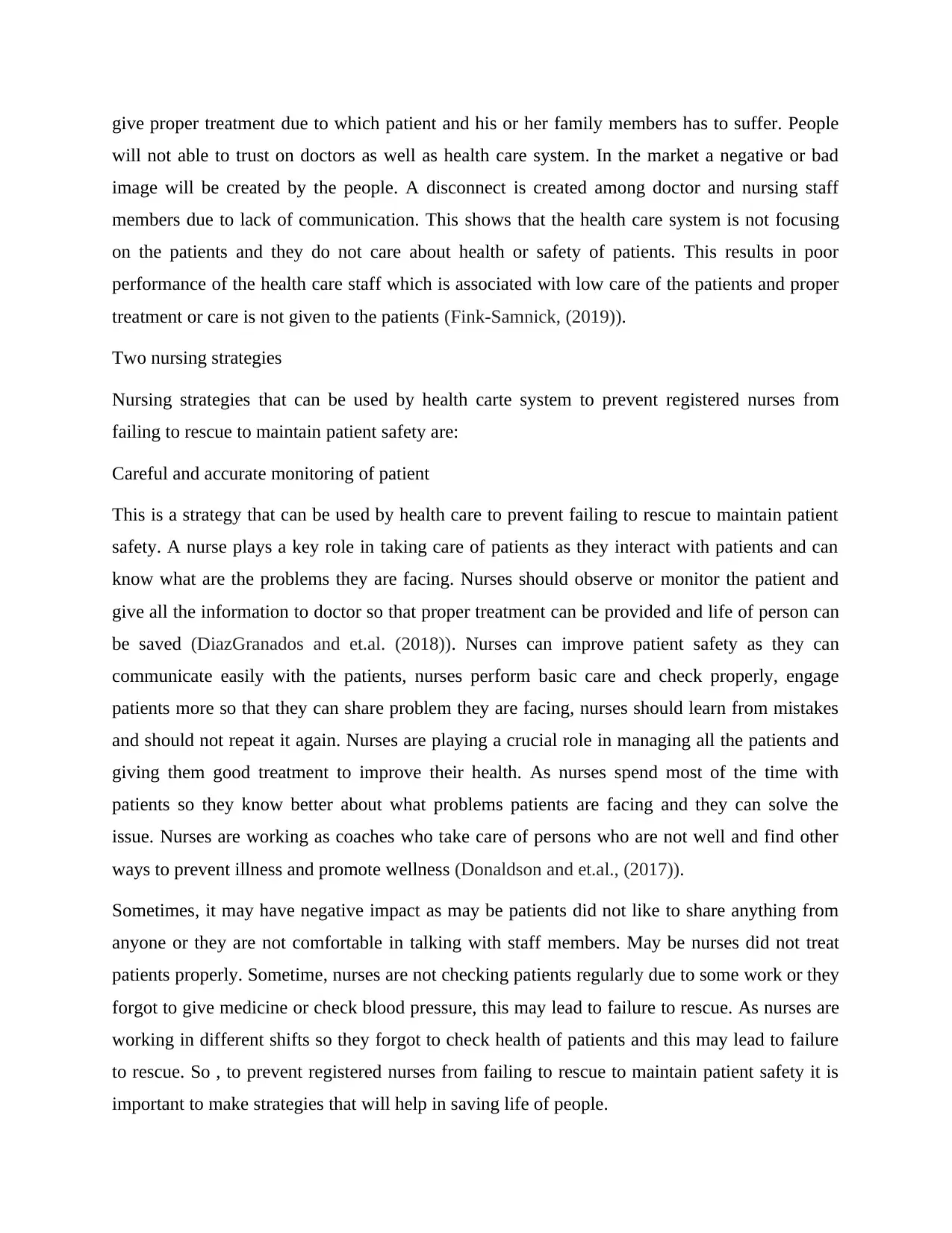
give proper treatment due to which patient and his or her family members has to suffer. People
will not able to trust on doctors as well as health care system. In the market a negative or bad
image will be created by the people. A disconnect is created among doctor and nursing staff
members due to lack of communication. This shows that the health care system is not focusing
on the patients and they do not care about health or safety of patients. This results in poor
performance of the health care staff which is associated with low care of the patients and proper
treatment or care is not given to the patients (Fink-Samnick, (2019)).
Two nursing strategies
Nursing strategies that can be used by health carte system to prevent registered nurses from
failing to rescue to maintain patient safety are:
Careful and accurate monitoring of patient
This is a strategy that can be used by health care to prevent failing to rescue to maintain patient
safety. A nurse plays a key role in taking care of patients as they interact with patients and can
know what are the problems they are facing. Nurses should observe or monitor the patient and
give all the information to doctor so that proper treatment can be provided and life of person can
be saved (DiazGranados and et.al. (2018)). Nurses can improve patient safety as they can
communicate easily with the patients, nurses perform basic care and check properly, engage
patients more so that they can share problem they are facing, nurses should learn from mistakes
and should not repeat it again. Nurses are playing a crucial role in managing all the patients and
giving them good treatment to improve their health. As nurses spend most of the time with
patients so they know better about what problems patients are facing and they can solve the
issue. Nurses are working as coaches who take care of persons who are not well and find other
ways to prevent illness and promote wellness (Donaldson and et.al., (2017)).
Sometimes, it may have negative impact as may be patients did not like to share anything from
anyone or they are not comfortable in talking with staff members. May be nurses did not treat
patients properly. Sometime, nurses are not checking patients regularly due to some work or they
forgot to give medicine or check blood pressure, this may lead to failure to rescue. As nurses are
working in different shifts so they forgot to check health of patients and this may lead to failure
to rescue. So , to prevent registered nurses from failing to rescue to maintain patient safety it is
important to make strategies that will help in saving life of people.
will not able to trust on doctors as well as health care system. In the market a negative or bad
image will be created by the people. A disconnect is created among doctor and nursing staff
members due to lack of communication. This shows that the health care system is not focusing
on the patients and they do not care about health or safety of patients. This results in poor
performance of the health care staff which is associated with low care of the patients and proper
treatment or care is not given to the patients (Fink-Samnick, (2019)).
Two nursing strategies
Nursing strategies that can be used by health carte system to prevent registered nurses from
failing to rescue to maintain patient safety are:
Careful and accurate monitoring of patient
This is a strategy that can be used by health care to prevent failing to rescue to maintain patient
safety. A nurse plays a key role in taking care of patients as they interact with patients and can
know what are the problems they are facing. Nurses should observe or monitor the patient and
give all the information to doctor so that proper treatment can be provided and life of person can
be saved (DiazGranados and et.al. (2018)). Nurses can improve patient safety as they can
communicate easily with the patients, nurses perform basic care and check properly, engage
patients more so that they can share problem they are facing, nurses should learn from mistakes
and should not repeat it again. Nurses are playing a crucial role in managing all the patients and
giving them good treatment to improve their health. As nurses spend most of the time with
patients so they know better about what problems patients are facing and they can solve the
issue. Nurses are working as coaches who take care of persons who are not well and find other
ways to prevent illness and promote wellness (Donaldson and et.al., (2017)).
Sometimes, it may have negative impact as may be patients did not like to share anything from
anyone or they are not comfortable in talking with staff members. May be nurses did not treat
patients properly. Sometime, nurses are not checking patients regularly due to some work or they
forgot to give medicine or check blood pressure, this may lead to failure to rescue. As nurses are
working in different shifts so they forgot to check health of patients and this may lead to failure
to rescue. So , to prevent registered nurses from failing to rescue to maintain patient safety it is
important to make strategies that will help in saving life of people.
Paraphrase This Document
Need a fresh take? Get an instant paraphrase of this document with our AI Paraphraser
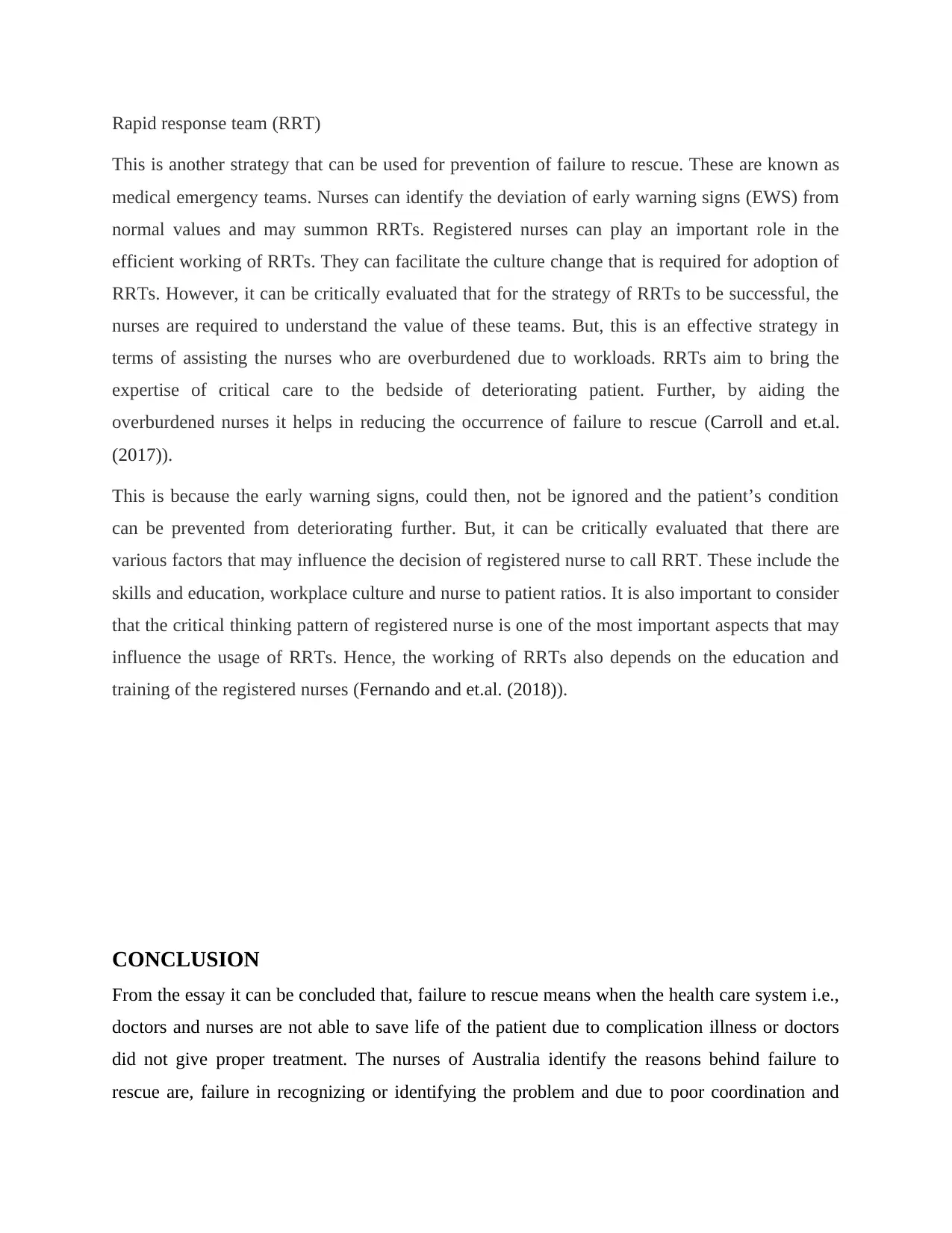
Rapid response team (RRT)
This is another strategy that can be used for prevention of failure to rescue. These are known as
medical emergency teams. Nurses can identify the deviation of early warning signs (EWS) from
normal values and may summon RRTs. Registered nurses can play an important role in the
efficient working of RRTs. They can facilitate the culture change that is required for adoption of
RRTs. However, it can be critically evaluated that for the strategy of RRTs to be successful, the
nurses are required to understand the value of these teams. But, this is an effective strategy in
terms of assisting the nurses who are overburdened due to workloads. RRTs aim to bring the
expertise of critical care to the bedside of deteriorating patient. Further, by aiding the
overburdened nurses it helps in reducing the occurrence of failure to rescue (Carroll and et.al.
(2017)).
This is because the early warning signs, could then, not be ignored and the patient’s condition
can be prevented from deteriorating further. But, it can be critically evaluated that there are
various factors that may influence the decision of registered nurse to call RRT. These include the
skills and education, workplace culture and nurse to patient ratios. It is also important to consider
that the critical thinking pattern of registered nurse is one of the most important aspects that may
influence the usage of RRTs. Hence, the working of RRTs also depends on the education and
training of the registered nurses (Fernando and et.al. (2018)).
CONCLUSION
From the essay it can be concluded that, failure to rescue means when the health care system i.e.,
doctors and nurses are not able to save life of the patient due to complication illness or doctors
did not give proper treatment. The nurses of Australia identify the reasons behind failure to
rescue are, failure in recognizing or identifying the problem and due to poor coordination and
This is another strategy that can be used for prevention of failure to rescue. These are known as
medical emergency teams. Nurses can identify the deviation of early warning signs (EWS) from
normal values and may summon RRTs. Registered nurses can play an important role in the
efficient working of RRTs. They can facilitate the culture change that is required for adoption of
RRTs. However, it can be critically evaluated that for the strategy of RRTs to be successful, the
nurses are required to understand the value of these teams. But, this is an effective strategy in
terms of assisting the nurses who are overburdened due to workloads. RRTs aim to bring the
expertise of critical care to the bedside of deteriorating patient. Further, by aiding the
overburdened nurses it helps in reducing the occurrence of failure to rescue (Carroll and et.al.
(2017)).
This is because the early warning signs, could then, not be ignored and the patient’s condition
can be prevented from deteriorating further. But, it can be critically evaluated that there are
various factors that may influence the decision of registered nurse to call RRT. These include the
skills and education, workplace culture and nurse to patient ratios. It is also important to consider
that the critical thinking pattern of registered nurse is one of the most important aspects that may
influence the usage of RRTs. Hence, the working of RRTs also depends on the education and
training of the registered nurses (Fernando and et.al. (2018)).
CONCLUSION
From the essay it can be concluded that, failure to rescue means when the health care system i.e.,
doctors and nurses are not able to save life of the patient due to complication illness or doctors
did not give proper treatment. The nurses of Australia identify the reasons behind failure to
rescue are, failure in recognizing or identifying the problem and due to poor coordination and
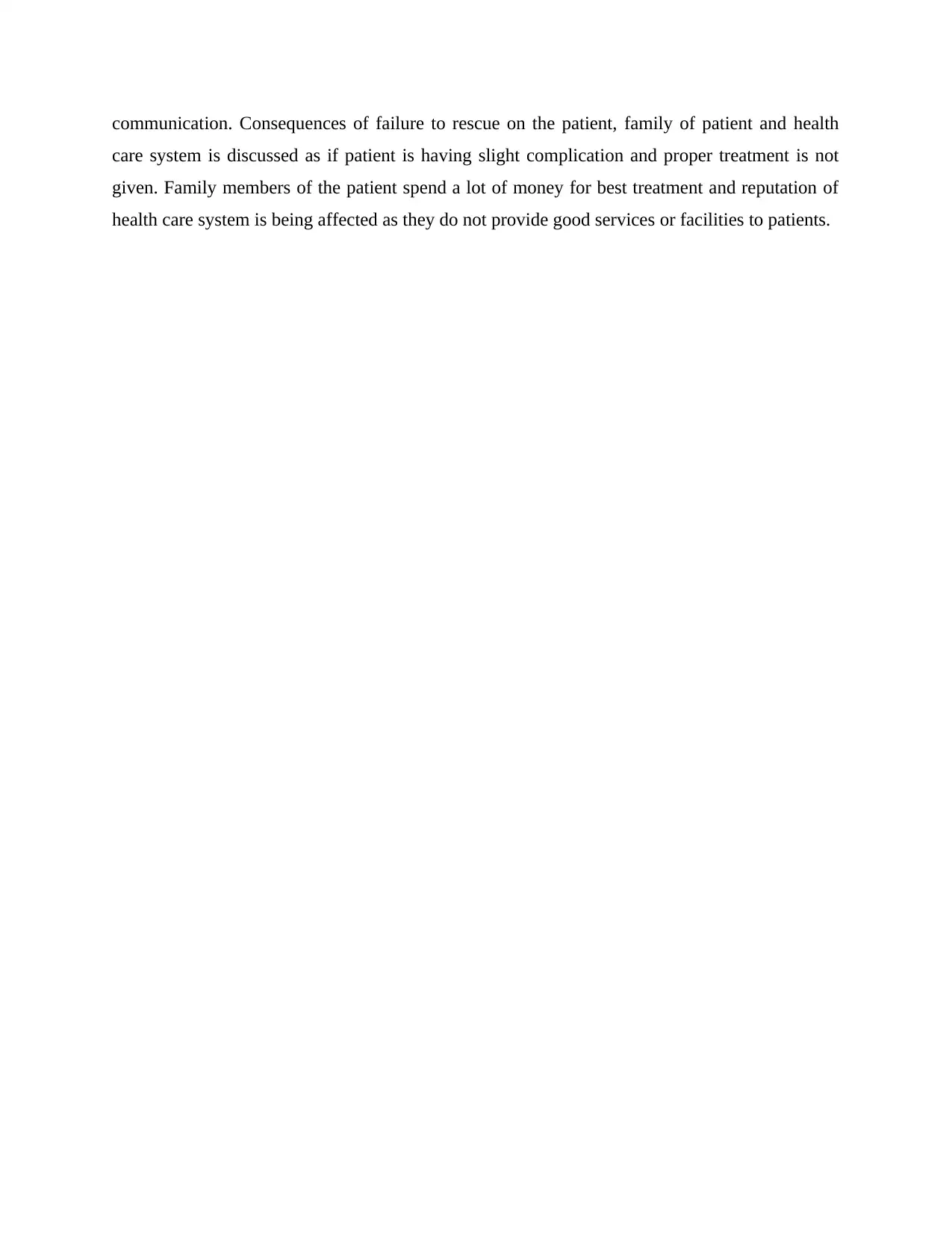
communication. Consequences of failure to rescue on the patient, family of patient and health
care system is discussed as if patient is having slight complication and proper treatment is not
given. Family members of the patient spend a lot of money for best treatment and reputation of
health care system is being affected as they do not provide good services or facilities to patients.
care system is discussed as if patient is having slight complication and proper treatment is not
given. Family members of the patient spend a lot of money for best treatment and reputation of
health care system is being affected as they do not provide good services or facilities to patients.
⊘ This is a preview!⊘
Do you want full access?
Subscribe today to unlock all pages.

Trusted by 1+ million students worldwide
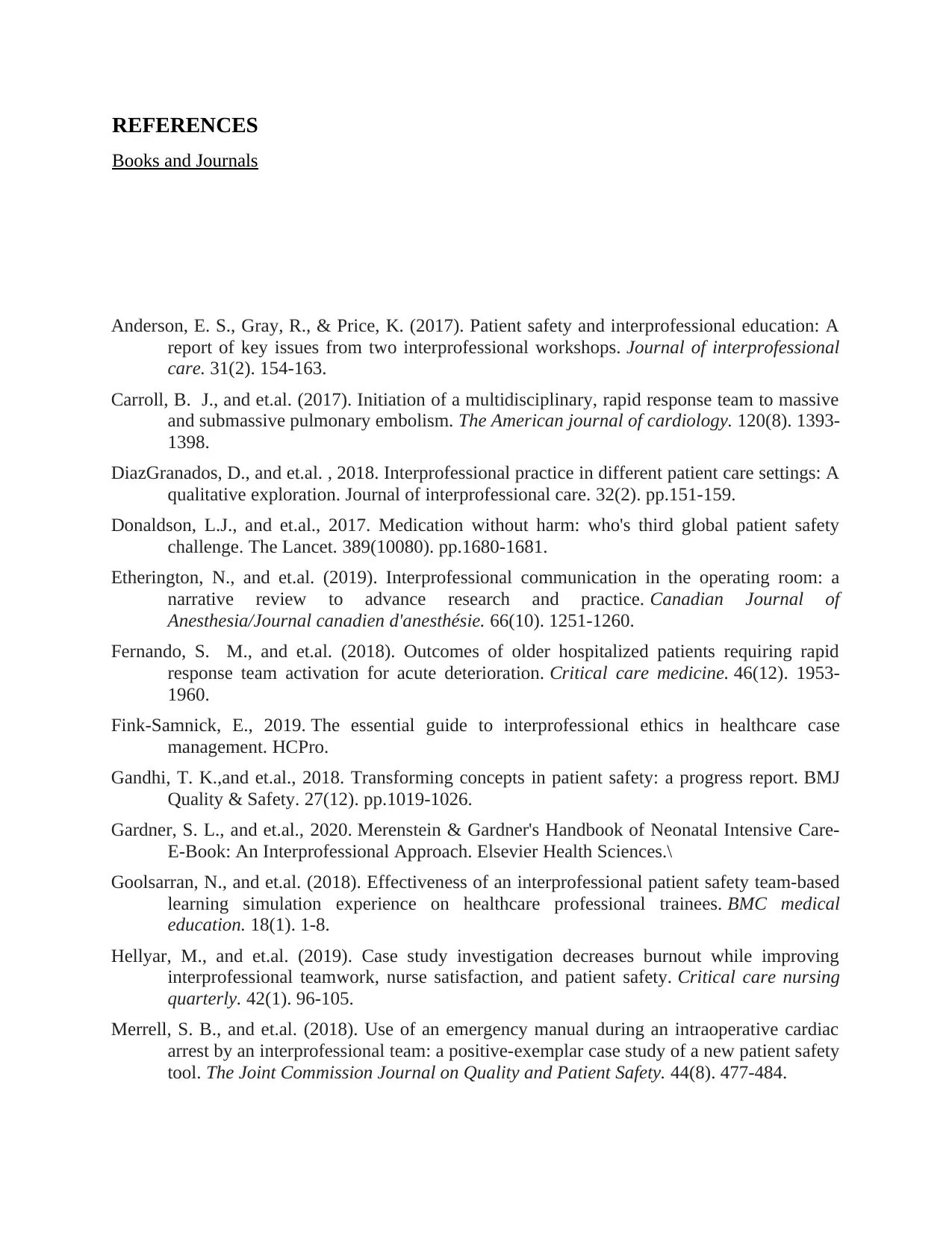
REFERENCES
Books and Journals
Anderson, E. S., Gray, R., & Price, K. (2017). Patient safety and interprofessional education: A
report of key issues from two interprofessional workshops. Journal of interprofessional
care. 31(2). 154-163.
Carroll, B. J., and et.al. (2017). Initiation of a multidisciplinary, rapid response team to massive
and submassive pulmonary embolism. The American journal of cardiology. 120(8). 1393-
1398.
DiazGranados, D., and et.al. , 2018. Interprofessional practice in different patient care settings: A
qualitative exploration. Journal of interprofessional care. 32(2). pp.151-159.
Donaldson, L.J., and et.al., 2017. Medication without harm: who's third global patient safety
challenge. The Lancet. 389(10080). pp.1680-1681.
Etherington, N., and et.al. (2019). Interprofessional communication in the operating room: a
narrative review to advance research and practice. Canadian Journal of
Anesthesia/Journal canadien d'anesthésie. 66(10). 1251-1260.
Fernando, S. M., and et.al. (2018). Outcomes of older hospitalized patients requiring rapid
response team activation for acute deterioration. Critical care medicine. 46(12). 1953-
1960.
Fink-Samnick, E., 2019. The essential guide to interprofessional ethics in healthcare case
management. HCPro.
Gandhi, T. K.,and et.al., 2018. Transforming concepts in patient safety: a progress report. BMJ
Quality & Safety. 27(12). pp.1019-1026.
Gardner, S. L., and et.al., 2020. Merenstein & Gardner's Handbook of Neonatal Intensive Care-
E-Book: An Interprofessional Approach. Elsevier Health Sciences.\
Goolsarran, N., and et.al. (2018). Effectiveness of an interprofessional patient safety team-based
learning simulation experience on healthcare professional trainees. BMC medical
education. 18(1). 1-8.
Hellyar, M., and et.al. (2019). Case study investigation decreases burnout while improving
interprofessional teamwork, nurse satisfaction, and patient safety. Critical care nursing
quarterly. 42(1). 96-105.
Merrell, S. B., and et.al. (2018). Use of an emergency manual during an intraoperative cardiac
arrest by an interprofessional team: a positive-exemplar case study of a new patient safety
tool. The Joint Commission Journal on Quality and Patient Safety. 44(8). 477-484.
Books and Journals
Anderson, E. S., Gray, R., & Price, K. (2017). Patient safety and interprofessional education: A
report of key issues from two interprofessional workshops. Journal of interprofessional
care. 31(2). 154-163.
Carroll, B. J., and et.al. (2017). Initiation of a multidisciplinary, rapid response team to massive
and submassive pulmonary embolism. The American journal of cardiology. 120(8). 1393-
1398.
DiazGranados, D., and et.al. , 2018. Interprofessional practice in different patient care settings: A
qualitative exploration. Journal of interprofessional care. 32(2). pp.151-159.
Donaldson, L.J., and et.al., 2017. Medication without harm: who's third global patient safety
challenge. The Lancet. 389(10080). pp.1680-1681.
Etherington, N., and et.al. (2019). Interprofessional communication in the operating room: a
narrative review to advance research and practice. Canadian Journal of
Anesthesia/Journal canadien d'anesthésie. 66(10). 1251-1260.
Fernando, S. M., and et.al. (2018). Outcomes of older hospitalized patients requiring rapid
response team activation for acute deterioration. Critical care medicine. 46(12). 1953-
1960.
Fink-Samnick, E., 2019. The essential guide to interprofessional ethics in healthcare case
management. HCPro.
Gandhi, T. K.,and et.al., 2018. Transforming concepts in patient safety: a progress report. BMJ
Quality & Safety. 27(12). pp.1019-1026.
Gardner, S. L., and et.al., 2020. Merenstein & Gardner's Handbook of Neonatal Intensive Care-
E-Book: An Interprofessional Approach. Elsevier Health Sciences.\
Goolsarran, N., and et.al. (2018). Effectiveness of an interprofessional patient safety team-based
learning simulation experience on healthcare professional trainees. BMC medical
education. 18(1). 1-8.
Hellyar, M., and et.al. (2019). Case study investigation decreases burnout while improving
interprofessional teamwork, nurse satisfaction, and patient safety. Critical care nursing
quarterly. 42(1). 96-105.
Merrell, S. B., and et.al. (2018). Use of an emergency manual during an intraoperative cardiac
arrest by an interprofessional team: a positive-exemplar case study of a new patient safety
tool. The Joint Commission Journal on Quality and Patient Safety. 44(8). 477-484.
Paraphrase This Document
Need a fresh take? Get an instant paraphrase of this document with our AI Paraphraser
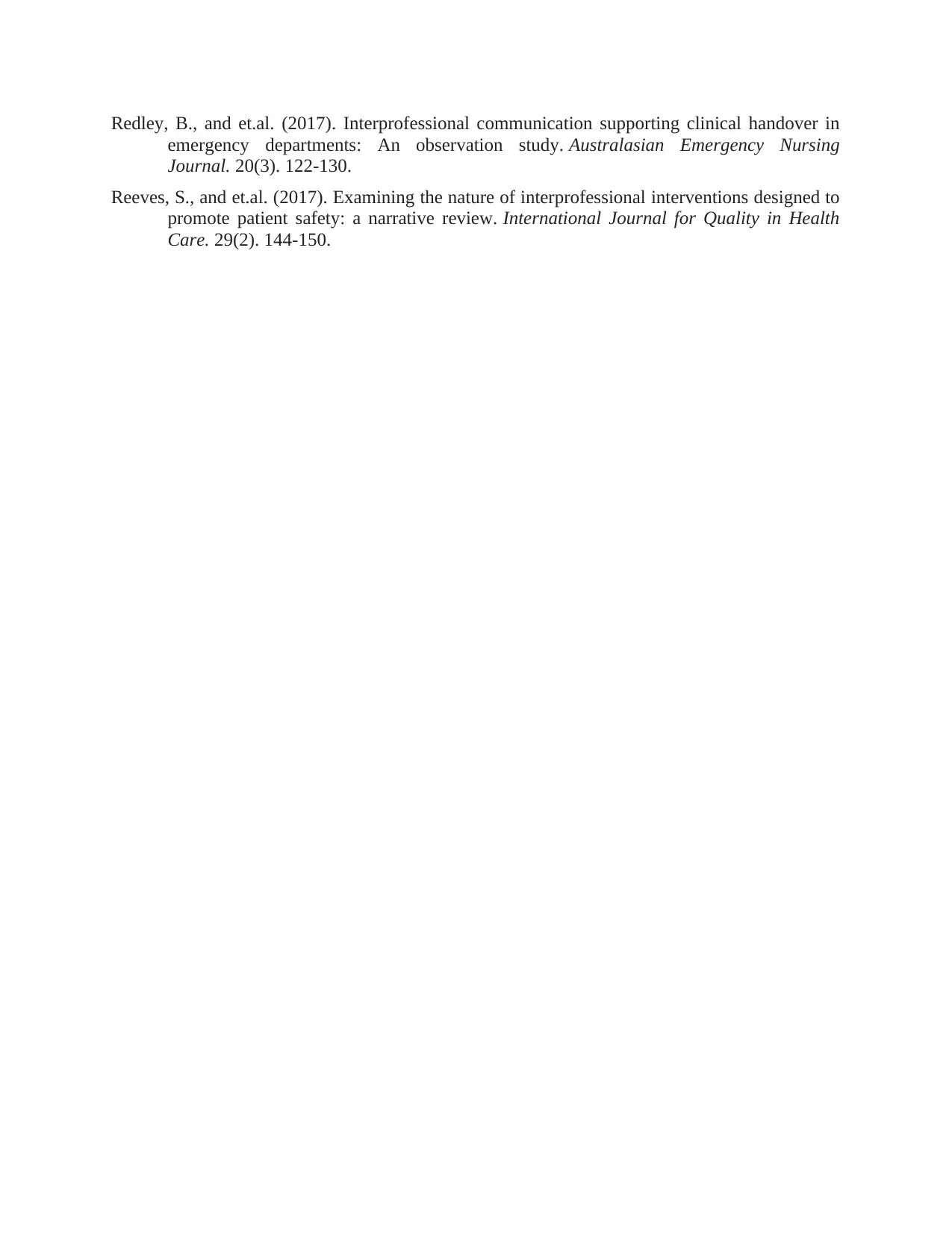
Redley, B., and et.al. (2017). Interprofessional communication supporting clinical handover in
emergency departments: An observation study. Australasian Emergency Nursing
Journal. 20(3). 122-130.
Reeves, S., and et.al. (2017). Examining the nature of interprofessional interventions designed to
promote patient safety: a narrative review. International Journal for Quality in Health
Care. 29(2). 144-150.
emergency departments: An observation study. Australasian Emergency Nursing
Journal. 20(3). 122-130.
Reeves, S., and et.al. (2017). Examining the nature of interprofessional interventions designed to
promote patient safety: a narrative review. International Journal for Quality in Health
Care. 29(2). 144-150.
1 out of 11
Related Documents
Your All-in-One AI-Powered Toolkit for Academic Success.
+13062052269
info@desklib.com
Available 24*7 on WhatsApp / Email
![[object Object]](/_next/static/media/star-bottom.7253800d.svg)
Unlock your academic potential
Copyright © 2020–2025 A2Z Services. All Rights Reserved. Developed and managed by ZUCOL.





